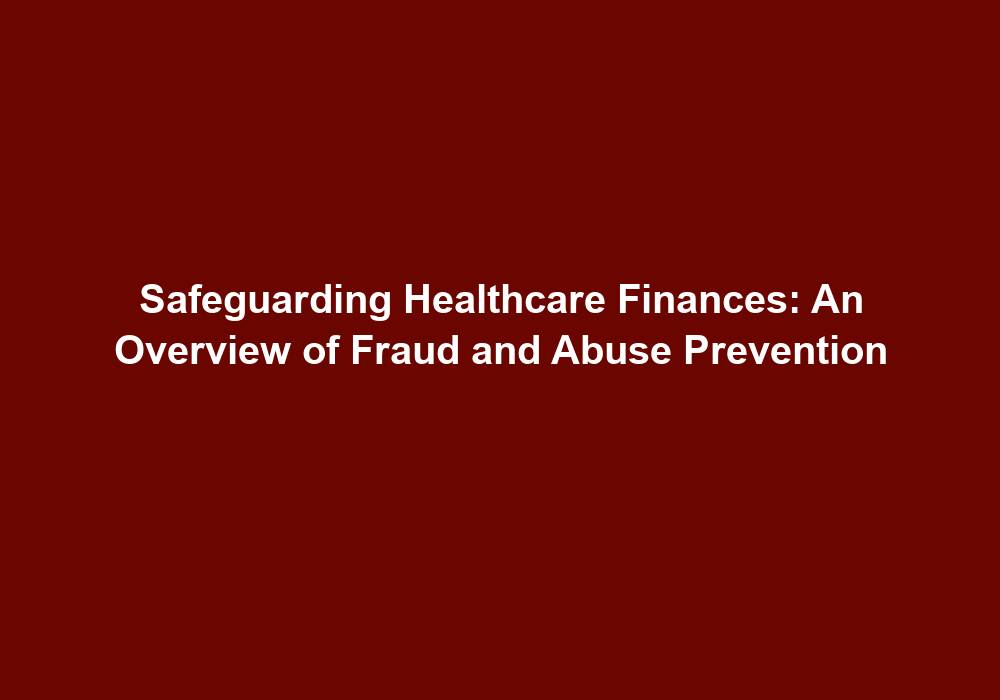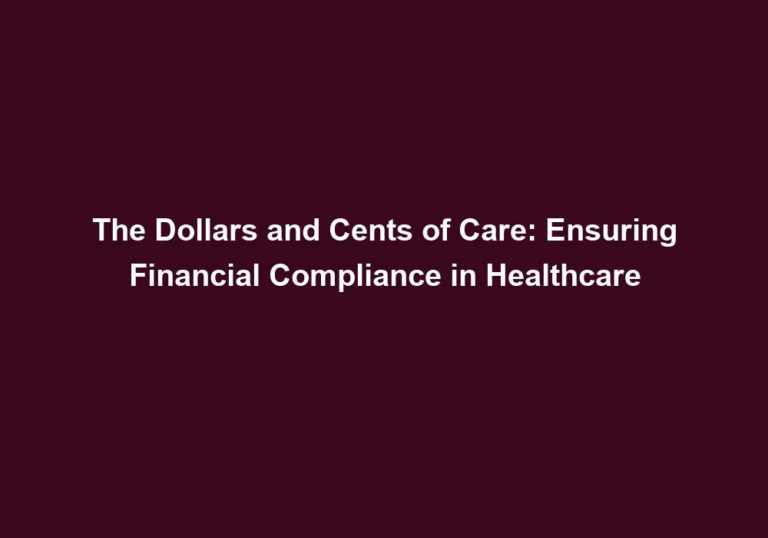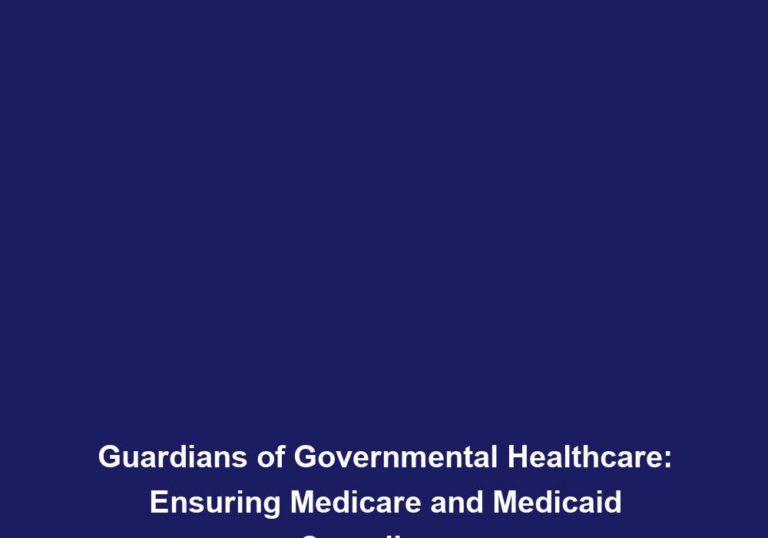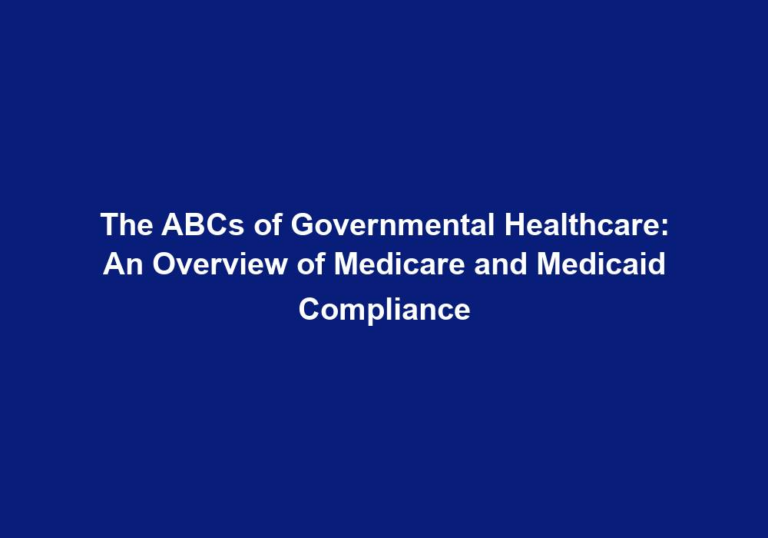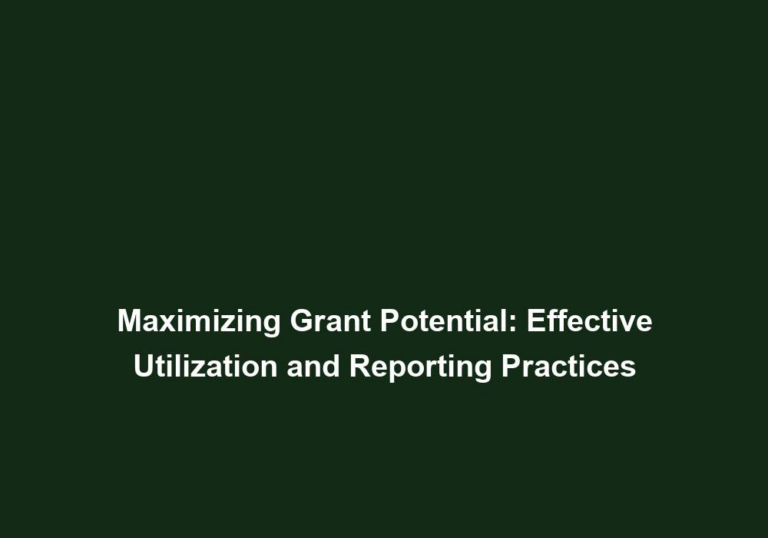Safeguarding Healthcare Finances: An Overview of Fraud and Abuse Prevention
In the healthcare industry, it is of utmost importance to prioritize the safeguarding of finances. The rising costs and complex financial systems necessitate proactive measures to prevent fraud and abuse, ensuring the integrity of financial operations within healthcare organizations. This article aims to provide an in-depth overview of fraud and abuse prevention strategies, emphasizing their significance in protecting healthcare finances.
Understanding Fraud and Abuse
Before delving into effective prevention strategies, it is crucial to have a clear understanding of fraud and abuse in the context of healthcare. Fraud refers to intentional deceptive activities aimed at obtaining unauthorized financial benefits. It involves deliberate misrepresentation, false claims, or manipulation of information for personal gain. On the other hand, abuse refers to practices that go against acceptable healthcare norms, resulting in unnecessary costs or improper use of resources.
The Impact of Fraud and Abuse on Healthcare Finances
The consequences of fraud and abuse extend far beyond healthcare organizations; they affect patients and the overall healthcare system as well. The financial impact can be significant, leading to inflated costs, reduced availability of resources, and compromised quality of care. Additionally, fraudulent activities can undermine public trust in healthcare providers and erode the reputation of organizations.
Proactive Measures for Fraud and Abuse Prevention
To effectively safeguard healthcare finances, organizations must adopt proactive measures that encompass various aspects of their operations. Here are some key strategies to consider:
Implementing Robust Compliance Programs
Establishing and maintaining comprehensive compliance programs is essential for preventing fraud and abuse. These programs should include written policies, procedures, and standards that explicitly address fraud risks and promote adherence to regulations. Regular staff training on compliance protocols, whistleblower hotlines, and internal audits are also crucial components of an effective compliance program.
- Developing comprehensive written policies, procedures, and standards that explicitly address fraud risks and promote adherence to regulations.
- Conducting regular staff training sessions to ensure all employees are aware of compliance protocols and understand their individual responsibility in preventing fraud and abuse.
- Implementing whistleblower hotlines to provide a confidential means for employees to report suspected fraudulent activities without fear of retaliation.
- Conducting internal audits on a regular basis to identify any potential areas of vulnerability and ensure compliance with established policies and procedures.
Conducting Regular Audits and Monitoring
Regular internal and external audits play a vital role in detecting potential fraud and abuse. These audits should be conducted by qualified professionals who can thoroughly examine financial records, billing practices, and coding accuracy. By monitoring financial transactions and data regularly, healthcare organizations can identify any discrepancies or suspicious activities, enabling timely intervention and prevention of further losses.
- Conducting regular internal and external audits by qualified professionals to thoroughly examine financial records, billing practices, and coding accuracy.
- Monitoring financial transactions and data on an ongoing basis to identify any discrepancies or suspicious activities that may indicate potential fraud or abuse.
- Utilizing data analytics tools to detect patterns and anomalies that may indicate fraudulent behavior, such as unusual billing patterns or excessive utilization of resources.
- Implementing proactive monitoring systems to identify red flags and potential fraudulent activities, allowing for timely intervention and prevention.
Ensuring Proper Documentation and Coding
Accurate documentation and coding are pivotal for preventing fraudulent claims and billing errors. Clear and concise medical records, with proper documentation of services provided, enable accurate billing and reduce the risk of fraudulent claims. Healthcare organizations must train their staff on proper coding practices to ensure compliance with coding guidelines and minimize errors.
- Emphasizing the importance of accurate and detailed documentation of services provided in medical records.
- Providing staff training on proper coding practices, ensuring compliance with coding guidelines and reducing the risk of billing errors.
- Implementing systems and processes to regularly review and validate coding accuracy, ensuring that claims are submitted correctly and in accordance with regulations.
- Utilizing technology solutions, such as electronic health records and coding software, to streamline documentation and coding processes, minimizing the risk of errors and facilitating accurate billing.
Strengthening Internal Controls
Robust internal controls are essential for preventing fraud and abuse within healthcare organizations. These controls include segregation of duties, regular reviews of financial transactions, and restricted access to sensitive information. By implementing strong internal controls, organizations can minimize the risk of unauthorized activities and detect any potential irregularities promptly.
- Implementing segregation of duties to ensure that no single individual has complete control over a financial transaction from initiation to completion.
- Conducting regular reviews and reconciliations of financial transactions to detect any discrepancies or potential fraudulent activities.
- Restricting access to sensitive information and financial systems to authorized personnel only, minimizing the risk of unauthorized activities.
- Implementing fraud prevention tools and technologies, such as fraud detection software and access controls, to enhance internal controls and mitigate the risk of fraud and abuse.
Emphasizing Ethical Practices and Accountability
Promoting a culture of ethical behavior and accountability is vital in preventing fraud and abuse. Healthcare organizations should establish clear ethical standards and provide ongoing training to employees on ethical conduct and the consequences of fraudulent activities. Encouraging employees to report any suspected fraud or abuse through confidential reporting mechanisms fosters a culture of accountability and deters potential wrongdoings.
- Establishing clear ethical standards and codes of conduct that outline expected behavior and promote a culture of integrity and accountability.
- Providing ongoing training and education to employees on ethical conduct and the potential consequences of fraudulent activities.
- Implementing confidential reporting mechanisms, such as anonymous hotlines or online reporting systems, to encourage employees to report suspected fraud or abuse without fear of retaliation.
- Conducting thorough investigations of reported incidents and taking appropriate disciplinary actions against individuals found to be engaged in fraudulent activities.
Collaborating with Law Enforcement Agencies
Collaboration with law enforcement agencies is crucial in the fight against healthcare fraud and abuse. Healthcare organizations should establish strong partnerships with local, state, and federal law enforcement agencies to share information and coordinate efforts. Reporting suspected fraudulent activities to the appropriate authorities helps initiate investigations and legal action, further deterring potential offenders.
- Establishing partnerships with local, state, and federal law enforcement agencies to share information and collaborate on investigations related to healthcare fraud and abuse.
- Reporting suspected fraudulent activities to the appropriate authorities, providing them with the necessary information and evidence to initiate investigations and legal action.
- Participating in joint task forces or working groups with law enforcement agencies to enhance coordination and cooperation in combating healthcare fraud and abuse.
- Sharing best practices and lessons learned with law enforcement agencies to strengthen prevention and detection efforts across the healthcare industry.
Leveraging Technology and Data Analytics
The use of advanced technology and data analytics can significantly enhance fraud and abuse prevention efforts in healthcare. Implementing robust data monitoring systems and employing predictive analytics can help identify patterns, anomalies, and red flags associated with fraudulent activities. By leveraging technology, healthcare organizations can proactively detect and prevent potential fraudulent schemes.
- Implementing robust data monitoring systems to continuously monitor financial transactions, claims data, and other relevant data sources for patterns and anomalies associated with fraudulent activities.
- Utilizing advanced data analytics tools and techniques, such as predictive modeling and anomaly detection algorithms, to identify red flags and potential fraudulent schemes.
- Implementing real-time alerts and automated notifications to promptly flag suspicious activities and enable timely intervention and prevention.
- Collaborating with technology vendors and industry partners to leverage cutting-edge technologies and best practices in fraud and abuse prevention.
Conclusion
Safeguarding healthcare finances from fraud and abuse requires a comprehensive and proactive approach. By implementing robust compliance programs, conducting regular audits, ensuring accurate documentation and coding, strengthening internal controls, promoting ethical practices, collaborating with law enforcement agencies, and leveraging technology, healthcare organizations can effectively protect their finances. Prioritizing fraud and abuse prevention not only safeguards financial integrity but also upholds the trust of patients and the integrity of the healthcare system.

